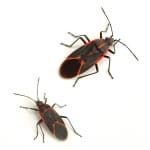Box Elder Bugs
Boxelder Bugs: Those Aren’t Fireflies!

Boxelder bugs are a nuisance pest known for their love of their namesake tree: the boxelder tree. Boxelder bugs feed on the seeds and leaves of boxelder trees, and have been known to do the same with other members of the maple family. While this behavior is not harmful to the host tree, swarms of boxelder bugs tend to congregate in the periphery of these trees, which can spell disaster for homeowners with boxelder trees on their property.
Boxelder bugs are sensitive to winter conditions, so when temperatures start dropping, they start looking for places to stay warm. Many of these bugs find such warmth on the sunny, south-facing sides of homes, where they group together in the thousands to sun themselves. As temperatures continue to drop, the boxelder bugs will continue to seek warmth, eventually finding their way into the infrastructure of the home via gaps in the siding and breaches in the foundation.
Once inside the wall voids of a home, boxelder bugs will attempt to enter a state of hibernation to wait out the winter. However, this process can be interrupted by a change of temperature, such as that created by a central heating system. When the bugs detect this temperature change, it confuses them, and causes them to behave as though spring has arrived. Rather than heading back outside, the bugs will instead move towards the warmth- and into the interior of the home. Their instinct then drives them to seek out a boxelder tree for sustenance. While they meander from room to room, they leave dark orange excretions in their wake, which can easily stain fabric and upholstery, as well as carpet, rugs, and even the walls/ceiling of the home. Boxelder bugs also emit a foul smell when crushed, so think twice before squishing them!
Boxelder bugs are harmless, yet hellacious little pests that can turn a suburban living room into the Temple of Doom in no time flat. Luckily, they’re predictable and preventable. Below are a few common behaviors of boxelder bugs, as well as some tips for keeping them out of your house:
Habits
Prevention and Tips
Boxelder trees attract boxelder bugs, and are widely considered a less-than-desirable tree due to their mundane appearance and their tendency to easily spread seedlings. If you’re planting new trees on your property, consider more desirable trees.
Boxelder bugs gain entry to the home via unsealed gaps in the exterior of the home, such as dryer vents, window frames, and poorly sealed doors. By ensuring all exterior wall penetrations are properly sealed, you can effectively deny boxelder bugs entry to the home.
If boxelder bugs have begun congregating on the side of your house, or even making their way inside, an effective way to round them up is by sucking them up with a (bagged) vacuum cleaner. Once all the bugs are in the vacuum bag, simply place the securely closed bag in your freezer overnight. This process kills the boxelder bugs without triggering their scent defenses.
Get a Free Estimate!
Request A Quote Today
...
Contact Us
Location :
44 Jason Ct, St Charles, MO 63304